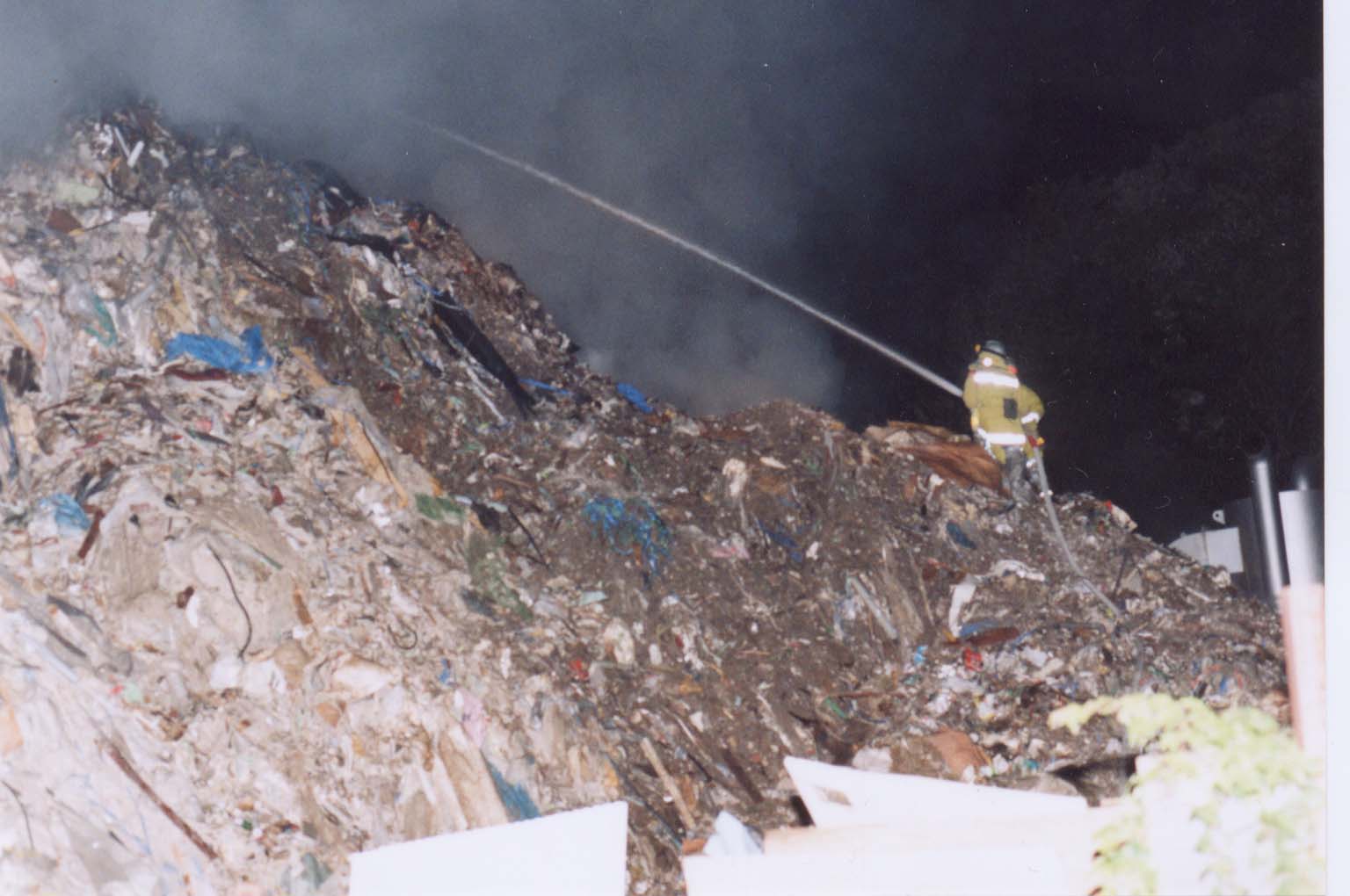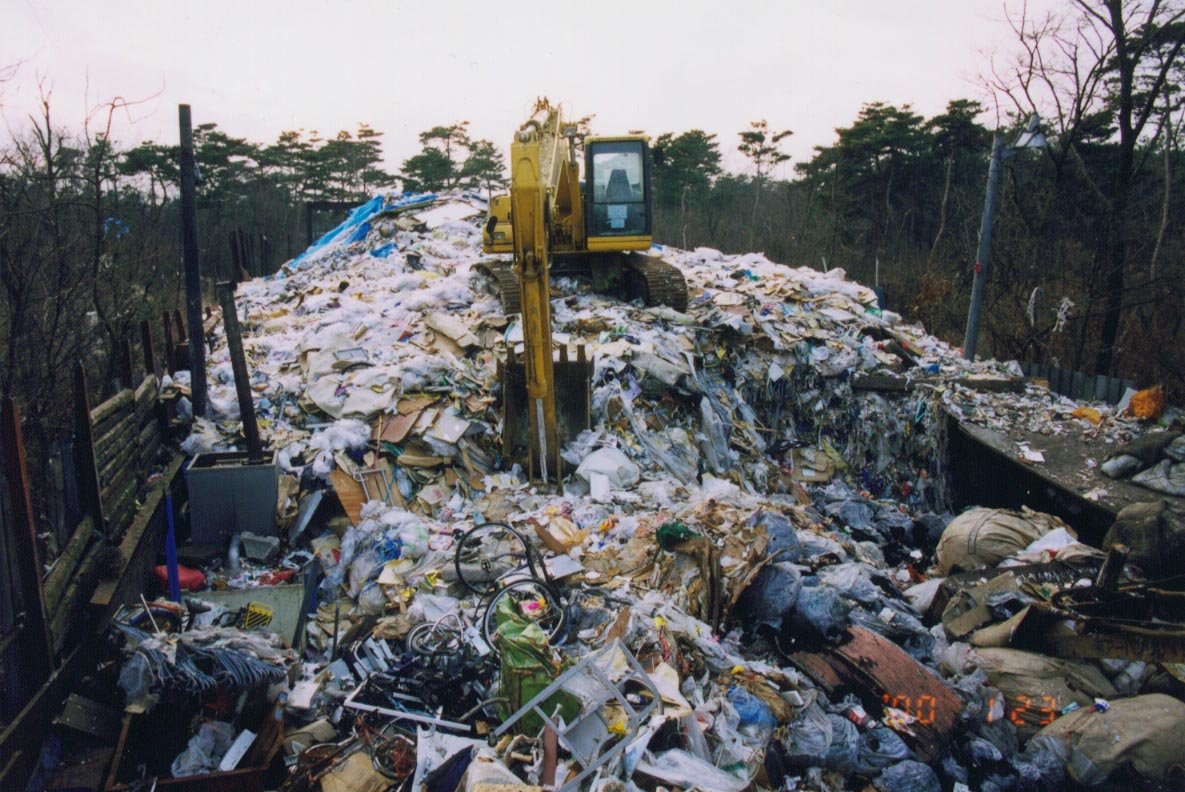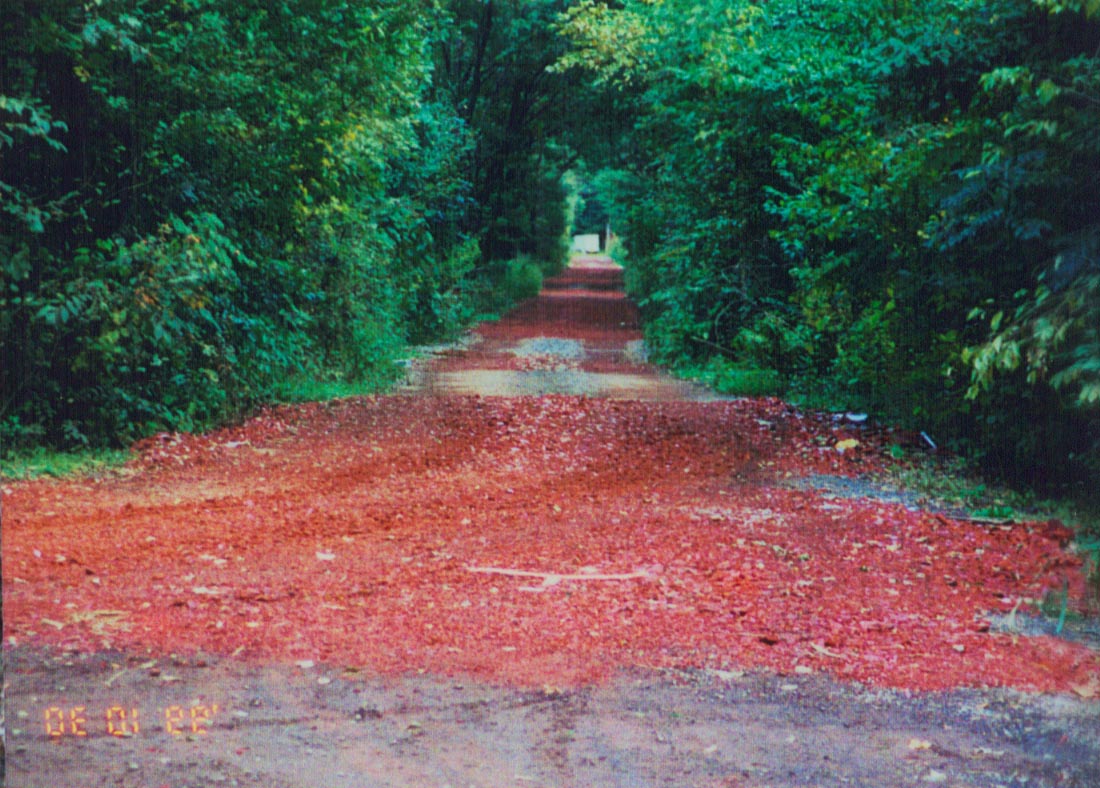1. Taisei Shoji (incinerator capacity 10m3/day): transshipment
interim storage permit for waste plastic, scrap metal and rubber,
glass and ceramic rubble, construction refuse.

2. A gigantic mountain of mixed waste material. Due to
the recent influx of refuse, the nearly ten-meter-high heap of
waste, comprised largely of plastic and rubber, threatened to
engulf the incinerator. On October 4, 1999, the mountain of refuse
went up in flames, and took firefighters six hours for to extinguish.
According to newspaper reports, around 500 tons of plastic and
rubber burned. Foul-smelling smoke issued continuously into the
surrounding area. Authorities stated that sparks from an electrical
fire in the machinery caused the refuse heap to catch fire. In
March 1999, the prefecture recommended to Taisei Shoji that they
clean up the site. The mountain of refuse continued to grow, but
the prefecture, instead of serving an order to clean up the site,
explained to citizens that they had advised the operators to clean
up the site, and the operators had said they would comply. When
citizens inspected the site on September 21 to review the maintenance
and temperature measurement logs, the cover on the temperature
measurement device could not be opened.
The responsibility for the fire lies largely with the prefecture
and its ineffective “advice”, which allowed the incinerator to
continue operating under conditions that were obviously a potential
fire hazard.
From the charred plastic remains it can be seen that complete
burning did not take place during the fire, and the smoke that
poured off the site could have been laden with any number of toxic
compounds, including dioxins. The charred mountain of refuse has
been left untouched. The prefecture finally issued a belated clean-up
order on November 2. The mountain of refuse is still there, putting
Taisei Shoji in violation of the order. Their incinerator permit
should be rescinded immediately.
3.  Urban Recycle:
transshipment interim storage permit for waste plastic, rubber
and metal scrap, glass and ceramic rubble, construction refuse.
Urban Recycle:
transshipment interim storage permit for waste plastic, rubber
and metal scrap, glass and ceramic rubble, construction refuse.
In August 1998, the prefecture issued a clean-up order in response
to leaching and spillover of wastes, and also noxious smells emanating
from the site. Urban Recycle temporarily cleaned up the site,
but soon after reverted to its former practices. The noxious smells
have returned, recognizable among them the smell of raw waste
for which Urban Recycle does not have a storage permit. The prefecture
belatedly issued a second clean-up order on November 2, 1999.
Urban Recycle should be immediately ordered to dismantle operations.
They have not yet complied with the order to clean up.
Kitada Shoji: license renewed October 27, 1999 for transshipment
interim storage of charred incinerator waste, sludge, waste oil,
plastic waste, animal carcasses, rubber and metal scrap, glass
and ceramic rubble, incinerator and smelter by-products and dregs,
metal slag, mining waste, construction scrap, fly ash.
Noxious smells issue from the refuse, which has been heaped
in an underground pit. Refuse on the bottom of the pit has been
there long enough that it could be undergoing chemical changes.
There have been a large number of citizen complaints.

Unlawful dumping in Kunugiyama
The public roads in Kunugiyama were originally designed as
walking paths, with a width from 1.8 to 4 meters. However, the
roads have been widened by incinerator operators to allow the
passage of wide-load trucks, and are now used frequently by over-sized
dump trucks carrying wastes. Trees have been felled without the
permission of the property owners. Even worse, the roads have
been raised as much as a meter from the surrounding forest floor,
making passage impossible for landowners in their small trucks.
The illegal adding of wastes to the roads continues. The roads
are multicolored, according to the type of waste. Black sections
look suspiciously like incinerator ash. This serves as yet another
example of illegal dumping that must be severely punished.
6. Can dioxin self-testing be trusted?
Because each of the dioxin self-tests done in this area shows
dioxin levels within regulatory standards, operators maintain
that the incinerators are not causing harm. However, even if the
tests are accurate for each individual incinerator, as the incinerators
are concentrated in a small area, the aggregate dioxin levels
could very well be above acceptable standards. Furthermore, citizens
have no way to check the accuracy of self-tests, and unfortunately
the figures may not represent actual emissions on a day-to-day
basis.
7. Problems with testing incinerator smokestack emissions
include:
The reliability of once-per-year testing under optimal conditions
for combustion, the fact that the amount of dioxins produced during
combustion varies according to what is being burned and how it
is being burned, and finally, tests done once per year under optimal
conditions tell us little about the actual day-to-day emissions.
8. What is being burned?
It has been pointed out that dioxin production during incineration
increases sharply in correlation to the amount of chlorine present
in materials being burned. Vinyl chloride is widely used in construction
materials, and the majority of incinerators in this area burn
construction refuse. It follows that the amount of dioxin produced
during emissions testing can be lowered by removing materials
containing vinyl chloride before waste is fed into the furnace.
There is no management system set up to insure that operators
operate their incinerators under usual conditions during self-tests.
Citizens visiting incinerator sites under usual conditions note
that the mountains of waste contain compound materials and waste
plastics. And the Tokorozawa City emergency dioxin emissions testing
in 1998 showed different figures from the self-testing results
of the incinerator operators.
Toumei Kyougyou self-test: 69ngTEQ/m3...City test: 96ngTEQ/m3.
Oozora Recycle self-tests: 150, 36, 72ngTEQ/m3,respectively...City:170ngTEQ/m3.
Shinmei self-test:3.3ngTEQ/m3...City: 92ngTEQ/m3).
9. Testing at standard operating conditions
In regard to emissions testing for batch-mode waste incinerators,
the Japan Ministry of Health and Welfare’s standard reference
manual for testing of dioxins instructs only to collect emissions
for four hours under normal operating conditions. More that half
of the dioxins emitted from batch incinerators (the type most
common in the Tokorozawa area) are produced during start-ups and
shutdowns, as evidenced by other test data. Saitama prefecture
collected dioxin emissions data under various operating conditions,
including start-ups and shutdowns. The dioxin levels ranged from
0.99ng TEQ (in full operation) to 58ng TEQ (during shutdown).
(See “Results of a Search for Strategies to Reduce Dioxin Production
in Waste Incinerators”, Saitama Prefecture Refuse Management Department,
8/10/1999.)
And as we have seen from the temperature measurement records of
industrial waste burners in the area, refuse is often added in
the middle of a burn, and standard operating temperatures rarely
stay above 800 degrees C. What are normal operating conditions?
And how much does a random four-hour test really tell us?
10. The 1998 Freedom of Information Act allowed citizens access
to Saitama prefecture documents listing industrial waste incinerator
sites (with the names blacked out) and the corresponding dioxin
test results. It is normal procedure for such reports to be accompanied
by documents from the Environmental Measurements Agency verifying
the authenticity of the test results, yet almost all the test
reports were unaccompanied by verifying documents. Furthermore,
many experts now believe that as testing for dioxin includes so
many complex procedures, it is nearly impossible for agency officials
to guarantee the accuracy of the above-mentioned data.
How can we trust data that no one can verify?
In Saitama prefecture, citizens are permitted to be present during
some dioxin tests, but every year many incinerator sites are tested
with only the operators present as witnesses. How can this be
considered satisfactory?
11. About dioxin concentration in the atmosphere
Since 1996, the prefecture and local governments have been sponsoring
spot testing for atmospheric dioxins at community centers and
school grounds in the Tokorozawa area. The test results (not including
co-PCB’s) show a range of dioxin concentration from 0.062 to 3.1
pgTEQ/m3. The authorities repeatedly do an annoying tap dance
around possible connections between source and effect. Officials
adamantly refuse to do any kind of testing other than to measure
ambient levels of a substance in a general area. (This policy
is not mandated or supported by law or regulation, and I do not
understand why authorities are allowed to behave this way. L.S.)
Atmospheric dioxin concentrations vary greatly according to weather
and conditions at the source of production, yet the tests are
made for one day only, four times per year. This type of spot
testing cannot possibly represent an accurate measure of the actual
concentration of ambient dioxins in the atmosphere.
The Japan Ministry of Health and Welfare has announced its intentions
to strengthen the standard for atmospheric dioxin concentrations
to 0.6pgTEQ/m3 Even
so, 1998 atmospheric dioxin tests done in the heavily incinerator-concentrated
areas of Kunugiyama and East Tokorozawa exceed the allowable limit
of 0.6pgTEQ/m3 which the Japan Ministry of Health and Welfare
says it will set in the near future. The test results show us
that there are high levels of dioxins ambient in the atmosphere
and that one does not have to directly inhale smokestack emissions
to be exposed to the dangerous effects.
There exists, however, data from on noteworthy joint test by the
Japanese and USA governments which monitored emissions from a
single source adjacent to the USA military base in Atsugi, Japan.
The emissions were constantly monitored from three points around
the source over a period of 56 days, from July 7 to Sept 1, 1999.
Most conspicuous were the data from the point north (site B) of
the source, recipient of the prevailing wind during that period,
where dioxin concentration fluctuated between 0.1pgTEQ/m3 and
53pgTEQ/m3 (with an average of 7.4pgTEQ/m3). Dioxin levels at
site A, west of the source, were from 0.085 to 3.3pgTEQ/m3 (average
0.64pgTEQ/m3), and to the south-southeast, site C had levels from
0.037 the 1.5pgTEQ/m3 (average 0.29pgTEQ/m3). Sites A, B, and
C were all located within one kilometer of the source. The direction
of the flow of smoke coincided with an enormous difference in
dioxin levels measured. Variances in the dioxin levels were evident
from day to day and can be attributed to variances in atmospheric
conditions and conditions at the source. The site which showed
pollution levels as high as 53pgTEQ/m3 also showed levels as low
as 0.1 pgTEQ/m3.
The above-mentioned source has three incinerators which each burn
30 tons per day. The waste allegedly consists of paper, wood,
fiber, and waste plastic. Self-tests by the operators show the
highest dioxin measurements at 22pgTEQ/Nm3.
It will be impossible to assess actual pollution levels of an
area such a Tokorozawa as long as officials refuse to do long-term
monitoring of pollution sources.
12. Summary and Conclusion
In the paragraphs above, we have shown that each incinerator site
is under suspicion of continued violation of recently strengthened
waste regulations, and that the Tokorozawa area is being seriously
polluted. In addition, the prefecture is shirking its duty to
oversee waste incineration, storage, and disposal of incinerator
by-products, especially ash. The responsibility to enforce regulations
lies with the prefecture. While citizens are fulfilling their
duties to report suspected violations to the prefecture, the prefecture
has not appropriately responded. The prefecture has not even bothered
to set up a system whereby authorities check to see if the waste
regulations are being upheld at incinerator and disposal sites.
The slack attitudes of the authorities encourage illegal waste
management processes, and the authorities have lost the trust
and respect of the citizens.
We wish that incinerator operations in violation of waste regulations
be brought to an immediate halt.
Since the law states that area citizens must be allowed to inspect
the operational logs if the citizens so wish, there should be
a system in place that facilitates easy inspection. And operators
should recognize that citizens are allowed to bring cameras onto
the site to take photo records of the logs.
We especially wish the prefecture authorities to immediately
implement the following:
1. Set up a system whereby authorities routinely and thoroughly
check temperature logs, ash by-products, type and amounts of refuse,
etc., and make public their findings.
2. Revoke licenses of those operators in violation of incinerator
regulations.
3. Revoke licenses of those operators in violation of storage
regulations. Charge violators for violations, and take strong
measures to crack down on violators.
4. When the engineering structure of the incinerator is so obviously
poor that it cannot possibly achieve complete burning, the incinerator
should be shut down, license revoked, and strong measures taken.
5. Dioxin tests on: soil from incinerator sites, wastewater from
the wet scrubbers, slag, ash, fly ash, and smokestack emissions
during start-ups, shutdowns, and full stops.
6. A true assessment of overall environmental pollution in the
areas of heavy incinerator concentration.
7. An assessment procedure that locates source of pollution and
areas most heavily affected by the source.
8. Redress of a system which allows exceeding amounts of waste
from outside the prefecture to be brought into Saitama to be incinerated.
(There are currently no regulations regarding transport of wastes
into Saitama prefecture.)
9. Penalties for transport of illegal wastes into the Kunugiyama
area.
10. Measures to restore and repair the environment.


 Urban Recycle:
transshipment interim storage permit for waste plastic, rubber
and metal scrap, glass and ceramic rubble, construction refuse.
Urban Recycle:
transshipment interim storage permit for waste plastic, rubber
and metal scrap, glass and ceramic rubble, construction refuse.